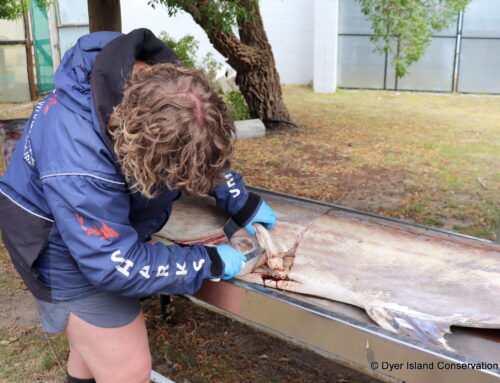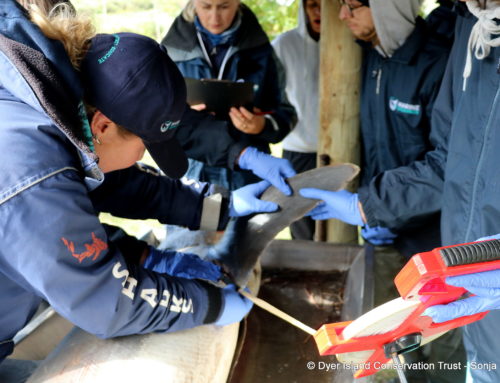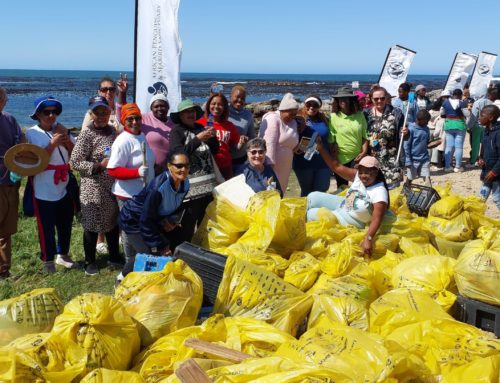A busy July for Alison Towner and the Great white sharks
July 26, 2011 by dyertrust
Studying great white sharks for the last five years in Gansbaai, I have often found myself out at sea wondering just what the sharks are up to on the other side of the headland- in False Bay. I have often imagined the same sharks I am seeing in Gansbaai and how they may behave if they were to swim around the corner and continue west along the coastline to the famous Seal Island. Essentially, they would inhabit a completely different bay system. Do they hunt differently- and are the sharks visiting Dyer Island able to compete with any of the seemingly huge breaching beauties Chris Fallows has timelessly captured on film there?
Well, last month I was given the opportunity of a lifetime, I was invited to False Bay to be on board White Pointer 2 with non other than Chris and Monique Fallows themselves. Whats more, leading the team, would be Jeff Kurr- one of Discovery channels most experienced and established shark documentary producers. Kurr has directed and produced each one of the classic Air Jaws documentaries with Chris co hosting, since back in the early 1990s. He has pioneered the global exposure around the flying white shark- and has always kept a balance between science, conservation, and the wow factor in his films. Our mission was to film False Bays flying whites- in all their glory for shark weeks 25th anniversary 2012, using the most up to date filming technology. The main aim was to show the white shark hunting around a seal colony like never before. My role- was to comment on what we saw, as it happened, from a scientific perspective- what a privilege!
As I left Gansbaai on the 21st of June, a week of westerly winds and swells had prevented anyshark taggingand tracking. My dedicated research team lead by our marine biologist and skipperOliver Jewellwere on standby to cover a tagging expedition if the weather played along, in my absence. Therefore, off I went!
I can honestly say, without giving too much away-the three weeks I spent at sea with the team in False Bay I will never forget. The first thing that struck me about the place was its beauty. The dramatic mountainous landscape forever changes its mood. In the morning, the sun rises up over the Hottentots mountains to the east, whilst on the opposite side, the most amazing magenta curtain cascades down Table Mountain, awakening the bay. Stormy days are equally as beautiful. As dark clouds gather, only staggered sunlight can penetrate, which in turn produces an almost heavenly- like gleam down the mountain edges, enhancing their proud contours. I learned fast, any photograph you get of any marine animal in False Bay- you want that background landscape in. Its one of the reasons why the Fallowss breach collection is so spectacular!
Being familiar with studying white sharks around Dyer Island, I found Seal Island really quite fascinating, and different. The first thing that struck me was the fact that there is no Kelp! Seal Island Is apparently very exposed and does not allow kelp forests to thrive due to high surge and unfavourable conditions. Seals and sharks often utilise the kelp patches surrounding Dyer Island and Geyser rock. We have seen time and time again, the seals rafting together and surfing the waves, as they break over the kelp, just offshore of the colony. We will also observe them bee lining for a patchy kelp reef as a pit stop before heading out into the open ocean to feed. White sharks hunting at Dyer will often patrol the edges of the kelp reef waiting, and if they are lucky, will get the chance to grab a seal that strays just that bit too far from the kelp edge. At Seal Island however-, the equation is a little less balanced and buffered for the seal! A cape fur seal leaving the colony in False Bay, is literally thrown into no mans land! When he and his group make the decision to go over the top and leave the colony to feed- there is a 25-30m drop off below, perfect for a stalking shark to line you up and launch an attack! Safety in numbers is therefore an important strategy for survival.
During the three weeks I spent in False Bay, myself and the team filmed every day possible, sometimes for 11 hours a day. We observed the seals and sharks at first light until dusk in an attempt to capture natural hunting behaviour. As one outbound group of seals shoots off across the launch pad (a sector of Seal Island the seals commonly depart from) another group follows shortly behind. Watching the seals, one cannot help but feel sorry for the youngest seal at the back of the group, desperately trying to keep up with the gang. To witness a white shark predation in the flesh is a truly moving experience. One morning we literally saw 14 predatory events, some successful some not- within an hour! I simply stood in awe on the top deck of Chriss boat as the super predators- I think I know so well- leapt sky high, crashing back down again with an almighty splash. Sometimes they even flashed their gleaming white belly at us (just out of courtesy). I was speechless, and the best thing was, we were actually capturing everything on film- right there and then in high definition- so if I asked the crew nicely we could play back and enjoy the memory over again!
Large male white sharks seemed to rule the hunting roost at Seal Island during the time I was there anyway, which I found quite interesting. One female shark that we tagged last September in Gansbaai Besom (see blogSeptember 2010) had made an appearance at Seal island literally days before I arrived. I looked for her everyday, but it seems she waited until I had left before she appeared again. Adrian Hewitt ofSave Our Seas foundationkindly notified me of her presence no less than a week after Id left! I have possibly recognised two maybe three sharks at Seal Island from Gansbaai. One individual was a heavily fouled male with distinctive patches of copepods along the edges of his pectorals and head. I saw him the last day of the shoot in False Bay and amazingly on returning to Gansbaai, Grant Tuckett from White Shark Projects re identified him in our inshore reef system area of Joubertsdam- incredible! He must have set off swimming to Gansbaai as we were heading over Sir Lowrys pass in our car.
One real highlight for me, was meeting some of False Bays famous fins. Cuz is a shark Ive been reading about in Moniques newsletter for years, and low and behold the last few days of my time at Seal island- who popped up to say hello other than the famous Cuz himself! Monique and I were beaming from the top deck as the fantastic shark circled the boat in such a relaxed manor really allowing everyone to enjoy his majesty. I also got to meet Bentley, and Round fin, both named due to the appearance of their dorsal fins, and both regular visitors to Seal Island.
I would just like to say a very big thank you to Chris, Monique, Poenas, Amy, Jeremy, and Woodsy who make up the crew ofApex expeditions. As a cage diving operation,Marine Dynamicshas always worked very closely with Apex expeditions as both share similar shark research and conservation ethos. The crew of White Pointer 2 not only know the sea and their vessel inside out, but their level of professionalism and passion for sharks is of the highest standard. Only years of experience with the white shark, (which Chris and Monique share over 20 together) can bring about such an experience for a passenger on their boat. It was inspiring to work with such like-minded people from just around the corner on the other side of the Cape! Id also like to thank Ezra, Johan and Brian a film crew who not only produced amazing footage in often challenging conditions, but were also a pleasure to spend long hours at sea with.
To see the footage you will have to wait for next year Im afraid, the documentary, which will be the next in the series of Air Jaws, will open up the 25th anniversary of shark week, sometime in July- keep an eye out on this blog for dates! Jeff will also be promoting the project on the Today show in the states on July 29th. The TODAY show joined the False Bay team and came out to shark dive with us here at Marine Dynamics- for which we were blessed with spectacular shark activity. Also, look out for Great White InvasionJeff and Chris filmed a segment of this film on board Lwazi with Oli and me last year. It should air in the USA on the 31st of July this year as the opening show for shark week, around 8pm US time.
New shark tagged
Finally, back to reality- and no time has been wasted! We have already deployed a tag on to a new shark. The 3.3m female has been named Claudine- after our very own Tannie Claudine. The Tannie (Afrikaans for Aunty) herself, has contributed a phenomenal amount of effort to raise funds for us to conduct shark andpenguin researchunder theDyer Island Conservation Trust, so this was just a little way for the team to show our appreciation to her. So far, the shark Claudine has taken us to some really interesting places whilst tracking her inshore of the bay. One particular location she decided to patrol, is an area close to Franskraal. The team and I have never tracked a shark so far east along the coast in this area or as close to the rocks! Shes certainly one of the more challenging animals to follow, and has a habit of moving off at high speed when shes done investigating an area. Interestingly she has not made her way up to Dyer Island, which is strange considering it is July. We have up to thirty hours of tracking on her so far, and look forward to the break in weather next week where we may be able to get one more night track done.
Until next month,Alison Towner




